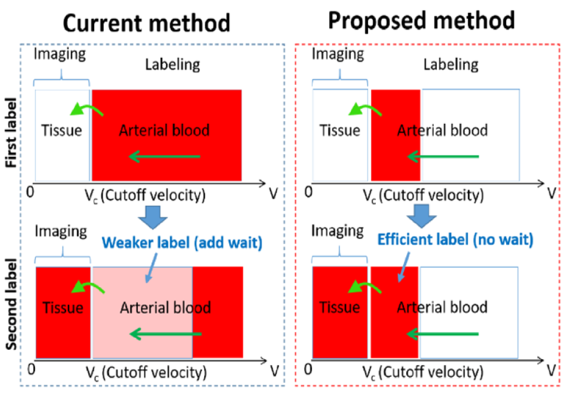Improving Perfusion Magnetic Resonance Imaging Using Ultra-Fast Arterial Spin Labeling
Background
Noninvasive perfusion (blood flow) imaging through Magnetic Resonance Imaging (MRI) techniques has been widely applied in imaging applications in medical, biological and other fields, using Arterial Spin Labeling (ASL). A typical ASL perfusion MRI technique produces an image of a selected body part under examination by manipulating the magnetic spins in arterial blood and processing measured responses in the target tissue. However, ASL MRI is a challenging procedure to perform in areas where blood flow is slow or obstructed due to vascular diseases, such as in stroke, or in applications where high temporal resolution is desired, such as in functional MRI.
Brief Description
Prof. Jia Guo and colleagues from the University of California, Riverside have developed a method for improving perfusion Magnetic Resonance Imaging (MRI) using Velocity Selective Arterial Spin Labeling (VSASL). This method uses VS labeling pulses that are capable to only label the blood that is moving within a narrow band of velocities and keep the blood moving at higher velocities unperturbed. This creates a small bolus of label that can be detected readily and quickly. This method provides MRI imaging that is far superior than conventional ASL MRI techniques with a doubled temporal resolution, improved signal-to-noise ratio (SNR) efficiency and quantification accuracy.

Fig 1: Schematics showing how UCR’s narrow-band velocity selectivity enables ultra-fast perfusion imaging
Applications
- To enable the use of ASL MRI in challenging applications such as stroke
- For use in fMRI applications for achieving superior temporal resolution
Patent Status
| Country | Type | Number | Dated | Case |
| Patent Cooperation Treaty | Published Application | WO 2022/023126 | 10/20/2022 | 2020-233 |
Additional Patent Pending
Related Materials
- Guo, J. Ultra-fast arterial spin labeling with narrow-band velocity-selectivity. Proc. Intl. Soc. Mag. Reson. Med. 29th (2021) p.2679.
Contact
- Venkata S. Krishnamurty
- venkata.krishnamurty@ucr.edu
- tel: View Phone Number.
Other Information
Keywords
MRI, arterial spin labeling, velocity selective arterial spin labeling, velocity selective inversion, magnetic resonance imaging, fMRI
